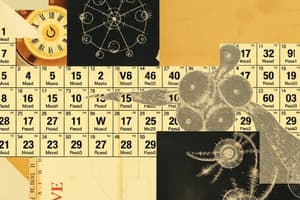Podcast
Questions and Answers
In what order did Mendeleev arrange the elements in the first Periodic table?
In what order did Mendeleev arrange the elements in the first Periodic table?
By atomic mass or properties within each column
What does the atomic number tell you about the atom of the element?
What does the atomic number tell you about the atom of the element?
How many electrons and protons are in the element
What does the atomic mass tell you about the atom of the element?
What does the atomic mass tell you about the atom of the element?
It tells you the weight of neutrons and protons
How do you know how many electrons there are surrounding the nucleus of a particular atom?
How do you know how many electrons there are surrounding the nucleus of a particular atom?
What does the periodic table represent?
What does the periodic table represent?
The group number represents the number of ______ in the outermost shell.
The group number represents the number of ______ in the outermost shell.
How many electrons can each energy level hold for each shell, #1-#4?
How many electrons can each energy level hold for each shell, #1-#4?
What is the last element in period 4?
What is the last element in period 4?
Elements in each group number all have what in common?
Elements in each group number all have what in common?
Define element.
Define element.
What is the maximum number of shells an electron can have?
What is the maximum number of shells an electron can have?
Which atomic particles are found in the nucleus and what are their charges?
Which atomic particles are found in the nucleus and what are their charges?
Which particle has a negative charge?
Which particle has a negative charge?
How would you label MOST reactive to LEAST reactive on the periodic table?
How would you label MOST reactive to LEAST reactive on the periodic table?
What is an ion?
What is an ion?
What is an isotope?
What is an isotope?
What do you call a column in a periodic table?
What do you call a column in a periodic table?
Who suggested that electrons travel around the nucleus in definite paths?
Who suggested that electrons travel around the nucleus in definite paths?
Who performed an experiment proving the existence of an atomic nucleus?
Who performed an experiment proving the existence of an atomic nucleus?
Who discovered that there are small particles inside the atom?
Who discovered that there are small particles inside the atom?
Who performed an experiment proving the existence of electrons?
Who performed an experiment proving the existence of electrons?
An isotope of Chlorine would have how many neutrons?
An isotope of Chlorine would have how many neutrons?
What do we call a row of elements on the periodic table?
What do we call a row of elements on the periodic table?
What does the zigzag line on the periodic table tell you?
What does the zigzag line on the periodic table tell you?
What 2 atomic particles do I add together to find an element's atomic mass?
What 2 atomic particles do I add together to find an element's atomic mass?
Flashcards are hidden until you start studying
Study Notes
Atomic Structure and Properties
- Mendeleev arranged elements in the first Periodic Table by atomic mass and similar properties.
- The atomic number identifies the number of protons and electrons in an element.
- Atomic mass indicates the combined weight of neutrons and protons in the atom.
- The number of electrons surrounding the nucleus equals the atomic number (also the number of protons).
- Atomic particles found in the nucleus include neutrons (neutral charge) and protons (positive charge).
- Electrons have a negative charge.
Periodic Table Organization
- The periodic table represents electron shells where elements are organized by energy levels.
- Group numbers reflect the number of valence electrons in the outermost shell.
- Elements in a group share similar chemical properties due to the same number of valence electrons.
- Maximum energy levels for electrons are 2 (1st shell), 8 (2nd & 3rd shells), and 18 (4th shell).
- The last element in Period 4 is Krypton.
- Each horizontal row in the Periodic Table is referred to as a period.
- The zigzag line on the table indicates properties of elements, differentiating metals from nonmetals.
Reactivity and Ions
- Reactivity decreases from left to right across the periodic table.
- An ion is formed when there is an unequal number of electrons compared to protons in the same element.
- An isotope contains an unequal number of neutrons of the same element.
Historical Contributions
- Niels Bohr proposed that electrons travel in definite paths around the nucleus.
- Ernest Rutherford conducted an experiment that confirmed the existence of an atomic nucleus.
- J.J. Thomson discovered particles inside the atom and proved the existence of electrons via experiments.
Atomic Mass Calculation
- To calculate an element's atomic mass, add the number of protons and neutrons.
Studying That Suits You
Use AI to generate personalized quizzes and flashcards to suit your learning preferences.




